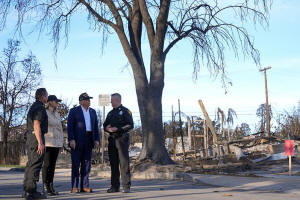Trump proposes 'getting rid of FEMA' while touring disaster areas
 Send a link to a friend
Send a link to a friend
 [January 25, 2025]
By WILL WEISSERT, CHRIS MEGERIAN and MAKIYA SEMINERA [January 25, 2025]
By WILL WEISSERT, CHRIS MEGERIAN and MAKIYA SEMINERA
LOS ANGELES (AP) — President Donald Trump surveyed disaster zones in
California and North Carolina on Friday and said he was considering
“getting rid of” the Federal Emergency Management Agency, offering the
latest sign of how he is weighing sweeping changes to the nation's
central organization for responding to disasters.
In fire-ravaged California, the state’s Democratic leaders pressed Trump
for federal assistance that he’s threatened to hold up, some setting
aside their past differences to shower him with praise. Trump, in turn,
pressured local officials to waive permitting requirements so people can
immediately rebuild, pledging that federal permits would be granted
promptly.
Instead of having federal financial assistance flow through FEMA, the
Republican president said Washington could provide money directly to the
states. He made the comments while visiting North Carolina, which is
still recovering months after Hurricane Helene, on the first trip of his
second term.
“FEMA has been a very big disappointment," the Republican president
said. “It’s very bureaucratic. And it’s very slow."
Trump was greeted in California by Gov. Gavin Newsom, a Trump critic
whom the president frequently disparages. The duo chatted amiably and
gestured toward cooperation despite their bitter history.
“We’re going to need your support. We’re going to need your help,”
Newsom told Trump. “You were there for us during COVID. I don’t forget
that, and I have all the expectations we’ll be able to work together to
get a speedy recovery.”

Newsom has praised Trump before when looking for help from the federal
government. In the early months of the coronavirus pandemic, he called
Trump “thoughtful” and “collaborative.”
Trump flew over several devastated neighborhoods in Marine One, the
presidential helicopter, before landing in Pacific Palisades, a hard-hit
community that’s home to some of Southern California’s rich and famous.
Accompanied by first lady Melania Trump, he walked a street where all
the houses have burned, chatting with residents and police officers.
It takes seeing the damage firsthand to grasp its enormity, Trump said
after. The fires, which continue to burn, could end up being the
costliest natural disasters in U.S. history.
“It is devastation. It really is an incineration," Trump said.
Trump’s brief but friendly interaction with Newsom belied the
confrontational stance he signaled toward California earlier in the day.
Even on the plane en route to Los Angeles, White House press secretary
Karoline Leavitt was using Trump’s disparaging nickname for the
governor, “Newscum,” and telling reporters “he has wronged the people of
his state” and saying Trump was visiting to pressure Newsom and other
officials “to do right by their citizens.”
Trump said Los Angeles residents who lost their homes should be able to
get back onto their properties immediately to clear them, adding several
told him it will be months before they can rebuild.
Mayor Karen Bass said residents should be able to return home within the
week, but keeping people safe from hazardous materials is a top
priority. She said the city was easing the process to get permits, but
she was repeatedly interrupted by Trump as she tried to explain the
city's efforts. He downplayed the concerns about toxins, saying: “What's
hazardous waste? We're going to have to define that.”
Trump has a long history of minimizing the risks of asbestos. In his
1997 book, “The Art of the Comeback,” Trump called asbestos “the
greatest fireproofing material ever used” and “100% safe, once applied,”
and claimed the movement against the insulator was led by the mob,
“because it was often mob-related companies that would do the asbestos
removal.”
Before flying to California, Trump reiterated that he wants to extract
concessions from the Democratic-led state in return for disaster
assistance, including changes to water policies and requirements that
voters need to show identification when casting ballots.
Beyond Trump’s criticism of FEMA, he’s suggested limiting the federal
government’s role in responding to disasters, echoing comments from
conservative allies who have proposed reducing funding and
responsibility.

[to top of second column]
|

President Donald Trump and first lady Melania Trump walk with Jason
Hing, chief deputy of emergency services at the Los Angles Fire
Department, left, and Capt. Jeff Brown, chief of Station 69, as they
tour the Pacific Palisades neighborhood affected by recent wildfires
in Los Angeles, Friday, Jan. 24, 2025. (AP Photo/Mark Schiefelbein)

“I’d like to see the states take care of disasters,” he said in
North Carolina. “Let the state take care of the tornadoes and the
hurricanes and all of the other things that happen.”
Trump said Michael Whatley, a North Carolina native and chair of the
Republican National Committee, would help coordinate recovery
efforts in the state, where frustrations over the federal response
have lingered. Although Whatley does not hold an official government
position, Trump said he would be “very much in charge.”
FEMA helps respond to disasters when local leaders request a
presidential emergency declaration, a signal that the damage is
beyond the state's ability to handle on its own. FEMA can reimburse
governments for recovery efforts such as debris removal, and it
gives stopgap financial assistance to individual residents.
Trump has criticized former President Joe Biden for his
administration’s response to Helene in North Carolina. As he left
the White House on Friday morning, he told reporters that “it’s been
a horrible thing the way that’s been allowed to fester” since the
storm hit in September, and “we’re going to get it fixed up.”
In a small town in western North Carolina, residents told Trump
about wading through waist-deep water to escape from their homes
while fearing for their lives. Some have battled with insurance
companies to get their losses covered.
“We’ve come to North Carolina with a simple message," Trump said.
“You are not forgotten any longer. You were treated very badly by
the previous administration.”
FEMA has distributed $319 million in financial assistance to
residents, but that hasn't alleviated the feeling of abandonment
among residents who are struggling to rebuild their lives.
Trump has showered California leaders with disdain for water
policies that he falsely claimed worsened the recent blazes. He said
he would “take a look at a fire that could have been put out if they
let the water flow, but they didn’t let the water flow.” In Los
Angeles, he met with members of Congress and local officials from
both parties in a meeting that was at times contentious.
Michael Coen, who served as chief of staff at FEMA during the Biden
administration, said Trump was “misinformed” about an agency that
provides critical help to states when they are overwhelmed by
catastrophe.

In addition, Coen criticized the idea of attaching strings to
assistance. "I think the American people expect the federal
government will be there for them on their worst day, no matter
where they live,” he said.
Trump tapped Cameron Hamilton, a former Navy SEAL with limited
experience managing natural disasters, as FEMA’s acting director.
Friday's trip could prompt some uncomfortable conversations about
climate change, which Trump has played down and denied. Both Helene
and the Los Angeles wildfires were exacerbated by global warming.
In Helene’s case, a study by international climate scientists at
World Weather Attribution found that climate change boosted the
storm’s rainfall by 10%. In California, the state suffered a record
dry fall and winter — its traditional wet season — which made the
area around Los Angeles more vulnerable to blazes.
“This is just breaking our comfort zone of what is supposed to be
normal,” said University of Oregon researcher Amanda Stasiewicz.
After visiting North Carolina and California, Trump plans to hold a
rally Saturday in Las Vegas.
___ Associated Press writers Stephen Groves, Seth Borenstein,
Jonathan J. Cooper, Kathleen Ronayne and Jill Colvin contributed to
this report.
All contents © copyright 2025 Associated Press. All rights reserved |